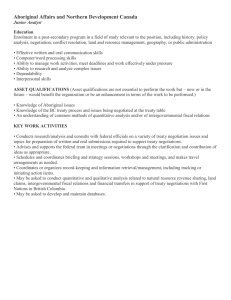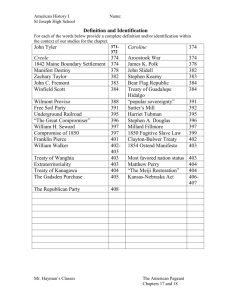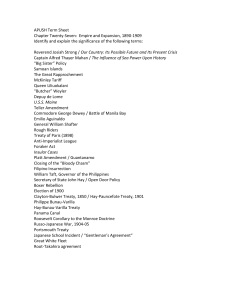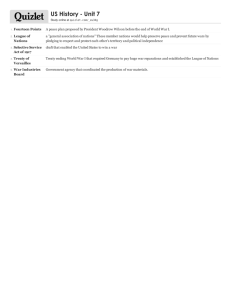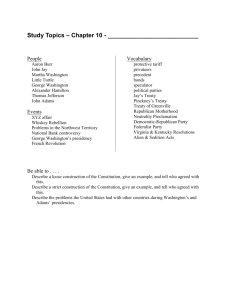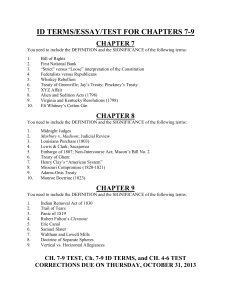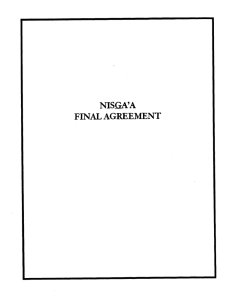THE SELF GOVERNMENT LANDSCAPE
advertisement
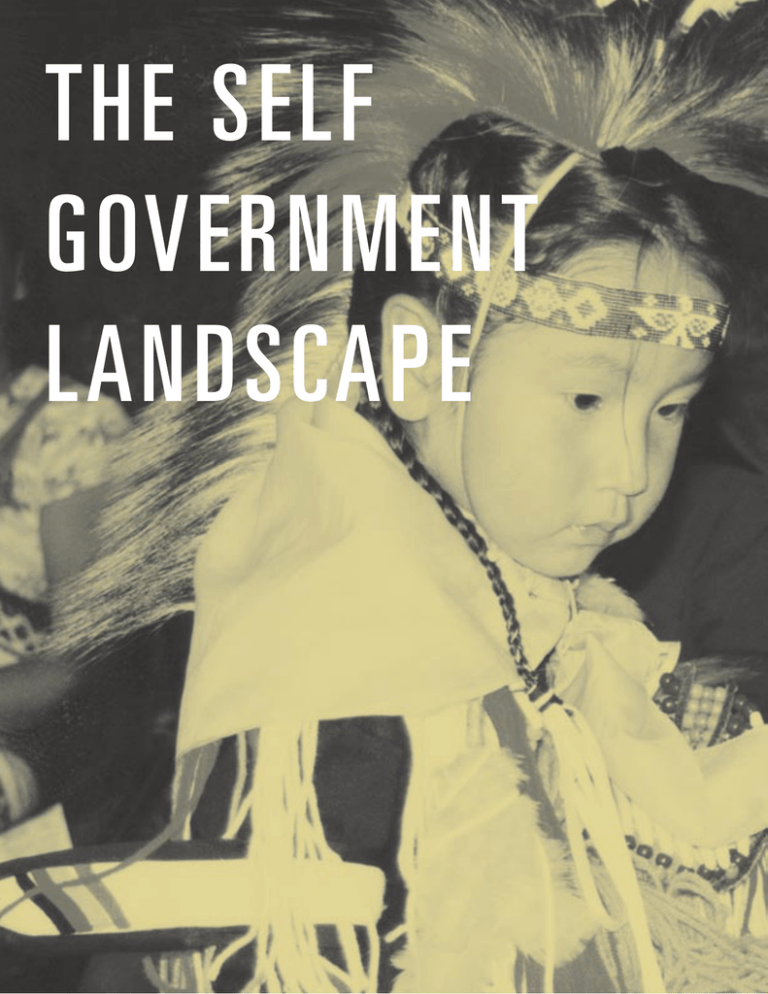
THE SELF GOVERNMENT LANDSCAPE WHY SELF G OV E R N M E N T ? This article was written by the Treaty Commission with The act of treaty making gives recognition to the participation of University of Northern British First Nations on their traditional territories as Columbia Professor Greg Poelzer, whose paper Inherent legitimate governments representing the interests of vs. Delegated Models of Governance, as well as several their constituents. Treaty negotiations afford us a other papers on self government, is available at unique opportunity to clarify the obligations, rights www.bctreaty.net and responsibilities of each government and establish a new relationship among First Nations and the Purpose First Nations were self-governing long before governments of Canada and BC. After treaties, First Nations will have agreed Europeans arrived in Canada. In 1876, the Indian Act ownership and jurisdiction over portions of their came into effect, undermining traditional governance traditional territories and the resources within them. systems and imposing regulations on aboriginal Self government is the principal means by which First peoples’ lives that, to a lesser extent, continue to this Nations formalize their relationship to those lands day. First Nations, for more than 100 years, have and resources today and preserve their traditions, demanded the right to govern themselves according to language and culture. First Nations will once again their own traditions – to be free of the Indian Act. have the autonomy to make decisions about their Aboriginal rights and treaty rights, both existing and those that may be acquired, are recognized and lives and their futures. Under the BC treaty process, it is intended that affirmed in Section 35 of the Constitution Act, 1982. each First Nation has the opportunity to negotiate a However the full scope of First Nation governance self government arrangement to meet its unique powers, potentially recognized and protected by the social, cultural, political and economic needs. constitution, remains unresolved by the courts. The BC Claims Task Force, established in 1991 Consequently, the obligations, rights and to make recommendations for a made-in-BC treaty responsibilities of the governments of Canada, BC process, envisioned that the self government and First Nations with regard to law-making arrangements within the treaty would have remain unclear. constitutional protection. Constitutionally protected We can continue to resolve the scope of First self government, as in the Nisga’a treaty, is passed as Nation governance powers through the courts, on a Canadian law. Constitutional protection ensures that case-by-case basis, or we can do so through treaty self-governing powers established by the treaty would negotiations. A negotiated resolution, which takes be very difficult to take away. into account the interests of all of the parties, rather than a solution imposed by the courts, is obviously the preferred approach. © Ktunaxa/Kinbasket Tribal Council, all rights reserved, reproduced with permission. Approaches Vary Self government for First Nations in British agreement between the First Nation and the Columbia and in other parts of Canada has taken Government of Canada, but is explicitly not a treaty. and will take, many forms. The Westbank self government agreement represents The Nisga’a Final Agreement is the first modern 16 | 17 Westbank self government takes its form from an an interim or incremental approach to self comprehensive treaty with constitutional protection. government while treaty negotiations are continuing Amendment requires the agreement of all three with the governments of Canada and BC. An interim parties – the treaty cannot be revoked unilaterally. It or incremental approach allows a First Nation to gain clearly spells out the continuing obligations, rights some self government powers now in order to achieve and responsibilities of each of the governments to the community goals and build further capacity for agreement. self reliance. The agreement sets out all areas where Nisga’a Although Westbank self government does not government can make laws. There are 14 areas in have constitutional protection, the proposed which Nisga’a laws prevail on Nisga’a lands and for agreement with Canada cannot be changed without Nisga’a citizens. Eight of these areas have little the consent of both parties. consequence for non-Nisga’a citizens, including, among other things, some Nisga’a government Scope of Goverance Negotiations institutions, citizenship, culture and language and the While governance provisions are being actively licensing of aboriginal healers. Nisga’a laws prevail in negotiated at some treaty tables, no self government six other areas of jurisdiction which have implications arrangements have yet been concluded under the BC for non-Nisga’a citizens and neighbouring treaty process. Governance negotiations typically communities. These include, for example, education address First Nation law-making powers, their source and forestry. Although Nisga’a laws prevail in these of authority and harmonization with the laws of areas, the laws must meet or exceed federal and/or Canada and British Columbia. provincial standards. In other words, Nisga’a The Principals have agreed to consider jurisdiction is qualified to ensure harmony with the incremental governance arrangements that would laws of Canada and British Columbia. serve as building blocks for a final self government The Sechelt Indian Band Self-Government Act agreement. In this way, through interim measures (1986) and the Westbank First Nation Self- agreements, the parties in individual negotiations can Government Agreement (1998), which has not been test governance arrangements before they are finalized ratified, differ from the Nisga’a Final Agreement. In through treaty negotiations. both cases self government authority is delegated from the federal and/or provincial governments. Sechelt self government is the result of Self Government Powers Specific law-making powers to be exercised by First negotiations among the three governments and the Nations will vary from treaty to treaty as each First federal and provincial governments passing legislation Nation is likely to negotiate self government to create Sechelt government. Through an agreement arrangements that meet its unique social, cultural, in principle reached at the treay table in 1999, Sechelt political and economic needs. sought to leave its 16-year-old self government arrangement in place. While specific First Nation law-making powers are a matter for negotiation, the parties have made some assumptions around their potential scope. For the proposed Westbank First Nation Self Government Agreement. However, the Indian Act is not intended to define example, it is anticipated that self government will be the nature and scope of any right of self government. exercised within the existing Canadian constitution. On the contrary, the limited range of powers that Therefore, aboriginal peoples would continue to be band governments are authorized to exercise under citizens of Canada and the province or territory where the Indian Act do not adequately equip First Nation they live, but may exercise varying degrees of governments with the tools necessary to develop jurisdiction and/or authority. Also, it is anticipated effective governing institutions and resolve the social the Charter of Rights and Freedoms and the Criminal and economic problems facing many First Nation Code of Canada would apply and that First Nations communities. would consult with non-aboriginal residents on decisions that directly affect them, for example, Harmonization of Laws health, school and police boards. Federal, provincial and aboriginal laws must work in harmony, particularly where governments share law- Source of Authority making authority. For example, under the Nisga’a The source of authority for First Nation law-making treaty, the Nisga’a and the provincial government powers is an issue the parties are endeavoring to share jurisdiction over wildlife. The Nisga’a treaty resolve through treaty negotiations. contains provisions that set out the respective roles First Nations assert their right to govern themselves is an inherent aboriginal right protected by and responsibilities of each government and define which laws will prevail in the event of a conflict. the constitution – the right is not given or delegated, but is based on their existence as organized societies in this country for thousands of year. The Government of Canada recognizes that aboriginal people have an inherent, constitutionally protected right to self government – a right to manage their own affairs. The BC Government has indicated a desire to negotiate a delegated form of self government. First Nations currently exercise a variety of lawmaking powers. For example, the inherent right is the source of authority for First Nation law-making in matters relating to customary marriages and adoption. First Nations also enact laws under authority delegated to band governments by the federal government under the Indian Act, or by federal or provincial legislation as is the case with Sechelt and in “First Nation government, often referred to as self government, will be an essential component of a new relationship.” BC Claims Task Force Report SELF GOVERNMENT: THE FIVE REALITIES 1 H I S TO R I CA L R E A L I T Y Prior to European settlement, aboriginal people were title or their right to self government. First Nations living in communities as distinct and self-sufficient see aboriginal title as an historical, lawful claim to nations. Each nation had its own language, its own whole traditional territories amounting to ownership. system of law and government and its own territory. When British Columbia joined Canada in 1871, Indian reserves currently cover approximately 0.4 per cent of the British Columbia land base, which aboriginal people, who were the majority, had no represents only a small portion of the land First recognized role in political decision-making. The Nations traditionally occupied and used. Terms of Union made no mention of aboriginal title to land. The Government of Canada assumed responsibility for “Indians and lands reserved for Indians.” The Government of British Columbia retained control over the creation of further Indian reserves and considered the “Indian land question” to have been resolved. Aboriginal people could not vote provincially until 1949 and federally until 1960 or stand for election and they could not pursue their claims in court. The federal and provincial governments would not address the land question or force the matter into the courts. First Nations were subjected to federal control under the constraints of the Indian Act. The “band” system of administration was imposed and federal officials made bands subject to detailed supervision that, to a lesser extent, continues to this day. In spite of these policies, the traditional values, identities, institutions and allegiances of the aboriginal peoples endured. In their communities and among their councils there is the profound conviction that their aboriginal title and their inherent aboriginal right to govern themselves remains in effect, that no treaty or other lawful action has extinguished that © Nisga’a Lisims Government, all rights reserved, reproduced with permission. “Justice Williamson, however, ruled not only that a limited form of self government survived confederation and was confirmed by s.35, but that the Nisga’a treaty properly and legitimately gave that limited right definition and content.” Hamar Foster, University of Victoria professor, speaking at a Treaty Commission conference in March 2002. 2 20 | 21 LEGAL REALITY Under section 35 of the Constitution Act, 1982, treaty violates the constitution by setting up a Nisga’a aboriginal rights and treaty rights, both existing and government with sweeping powers that are legally those that may be acquired, are recognized and reserved for the federal and provincial governments. affirmed. In Calder (1973), the Supreme Court of Canada The court was asked to decide whether the Nisga’a treaty created a new order of government so ruled that if there is an aboriginal historical presence as to require an amendment of Canada’s constitution. on the land, aboriginal title could be recognized at Sections 91 and 92 of the British North America Act, common law – without the need for any action by it was argued, divide all law-making power between the provincial or federal governments. the federal and provincial governments. The recognition of aboriginal title in Calder The court said the aboriginal right to self as a legal right was sufficient to cause the federal government was one of the underlying values of the government to establish a comprehensive land constitution that remained outside the powers that claims process. were distributed to parliament and the provincial In Sparrow (1990), the Supreme Court ruled that legislatures in 1867. unless legislation had a “clear and plain intention” to extinguish aboriginal rights, it did not have that effect, so those rights are continuing. After 1982, aboriginal rights and title were further protected from extinguishment by Canada’s constitution. In Delgamuukw (1997), the Supreme Court decision confirmed that aboriginal title exists in British Columbia, that it’s a right to the land itself – not just the right to hunt, fish or gather – and that when dealing with Crown land, the government must consult with and may have to compensate First Nations whose rights may be affected. In Campbell (2001), the BC Supreme Court ruled self government is an aboriginal right. The legal argument that all power in Canada is held by the federal or provincial governments was rejected by Justice Paul Williamson. The BC Liberal Party, then in opposition, challenged the Nisga’a Final Agreement arguing the “We can’t put those (aboriginal) rights or title on hold while we negotiate treaties. The rights and title exist now as obligations and responsibilities that lie upon both the provincial and federal governments.” Geoff Plant, Attorney General and Minister Responsible for Treaty Negotiations, speaking at an open Cabinet meeting in October 2001. 3 P O L I T I CA L R E A L I T Y In 1990, there was both a political need and an goal is an end to the Indian Act in favour of First appetite for beginning treaty negotiations with Nation governance. First Nations. Direct action by First Nations was prominent Minister Nault reiterated Canada’s position in July 2002 saying, “Our position has been very clear. It throughout the 1970s and 1980s, with sit-ins, won’t change. We don’t believe that municipal style blockades and rallies. In the 1980s these actions were type government for First Nations is on. We’ve been aimed at asserting aboriginal title and halting specific down that road many years ago; it has not been resource development projects. effective, nor will it work.” The province’s refusal to participate in negotiations was beginning to tell. Direct action and court rulings had delayed resource development projects pending the outcome of disputes over aboriginal rights and title. Economic activity was disrupted and investment in the province was down. Price Waterhouse calculated the cost to British Columbia of not settling land claims to be $1 billion in lost investment and 1,500 jobs a year in the mining and forestry sectors alone. As a result, the BC government made the decision to join First Nations and Canada in resolving long-standing issues through negotiations. Then in 1991, First Nations and the governments of Canada and British Columbia agreed to a made-in-BC treaty process for resolving the dispute over title to land in this province. A task force made 19 recommendations for creating a BC treaty process. Its report said, “First Nation government, often referred to as self government, will be an essential component of a new relationship.” The Government of Canada in 1995 announced its policy to implement the inherent right to aboriginal self government, paving the way for self government negotiations to occur across Canada. The “We can't wait – and the younger generation of First Nations peoples will not wait – for inherent rights to mean more than words on a page.” Robert Nault, Minister of Indian and Northern Affairs, speaking at a Treaty Commission conference in March 2002. 4 22 | 23 ECONOMIC REALITY A 13-year study of indigenous nations in the United The second critical factor, not surprisingly, is that States has found economic success is closely linked to good government is essential to economic success. the power to make decisions. Cornell said governments establish and enforce the Dr. Stephen Cornell, co-author of the Harvard rules of the game. “Those rules send a message to Project on American Indian Economic Development, investors – everybody from some person thinking of says their projects research has yet to find a single case taking a job in the nation’s government to someone in the United States of sustained economic activity on thinking of starting a small business on reserve land – indigenous lands in which a government body other and the message is either, ‘Do or don’t invest here’.” than the indigenous nation itself makes the decisions Thirdly, the governing institution must be about government structure, natural resource use, culturally appropriate and have the support of internal civil affairs and development strategies. the people. The economic research has found four critical factors for success: “Institutions that match contemporary indigenous cultures are more successful than those 1 Jurisdiction (self government) matters. that don’t,” said Cornell. “On the other hand, there is 2 Effective governing institutions are necessary. no blank cheque: institutions have to perform. We’ve 3 Governing institutions must be appropriate to the seen nations who have admitted their traditional way people. 4 The indigenous nation must have a strategic orientation. of doing things isn’t up to the challenges they currently face, but that doesn’t mean they just grab a set of institutions off the shelf … it means they spend some hard time trying to invent new institutions that they Speaking to the Treaty Commission conference, Speaking Truth to Power III, on self government in believe in and that are capable of getting the job done.” The fourth factor for success is strategic March, Cornell said jurisdiction matters because, “it orientation. A strategic orientation “encourages puts the development agenda and control of the politicians to serve the nation instead of themselves necessary resources in indigenous hands. because there is an explicit sense of what it is the “Without jurisdiction, indigenous nations are nation is trying to do.” subject to other people’s agenda. You can’t ask people to be accountable if you don’t give them decisionmaking power. Whoever is making the decisions has the accountability. Jurisdiction marries decisions to consequences, which leads to better decisions.” “We think the focus of attention should be on helping indigenous nations build themselves through competent governments that are of their own making.” Dr. Stephen Cornell, co-director, Harvard Project on American Indian Economic Development, speaking at a Treaty Commission conference in March 2002. 5 O N E F I R S T N AT I O N ’ S R E A L I T Y Excerpts from a presentation by Chief Sophie Pierre, One of the most difficult realities that we face is Ktunaxa/Kinbasket Tribal Council administrator, to the that our previous method of governance, the Ktunaxa Treaty Commission conference on self government, governance, has been largely lost through the March 2002. legislated restriction of First Nations cultural practices within Canada. As we redevelop our governance What makes a society? How do you recognize a system, we face an enormous challenge … we have to society? We believe there are four main characteristics, consider how to blend, first of all, our relationship four pillars, if you will, like the four directions. These with and within Canada and British Columbia, pillars represent our land, our people, our language secondly, community comfort levels and the new and culture and our governance structure. It’s pretty distribution of powers and authorities and much the same the world over. When you threaten expectations created under the last century of one of these, as we see in the Middle East, it leads to governance under the Indian Act and lastly, elements war. The ability to govern is the heart of any nation. of historical government structures and powers that In our contemporary world this is always the have withstood the passage of time. We need to be understanding: we all exist within a broader context creative on how we blend those three areas. that places limits on our internal decisions. We, the Ktunaxa people, have governed We recognize there are many challenges in developing governance methods to replace current ourselves, followed our cultural beliefs and traditions governance structures within our communities. since beyond time in memory. Traditional leadership However, we have evolved and adapted through many roles and responsibilities have always been tied to a upheavals and we are confident that we will continue collective survival. All citizens understand their role to grow and change to meet these challenges. and value within their community and tribe and Our treaty process is a nation-driven process – all respect the role and value of other citizens within citizens will be consulted on all aspects of the treaty. their tribe. All citizens will be well informed; all decisions will be Our ability to exercise full governance has been limited by the relatively recent imposition of the Indian Act. The imposition has forced a great deal of made in the best interests of our land, resources, culture, language and the future of the nation. A community education and citizen involvement difficult change and adjustment within the nation. process has evolved over this time. The Treaty This new system of governance is deeply flawed for Council sponsors community meetings in all five our situation and I argue it is flawed for all aboriginal communities on a monthly basis. It's the forum to people in Canada. New distributions of power and review treaty-related documents, refine collective authority have created deep divisions within our interests on topics and generally keep on top and communities. review what's going on. There are also youth liaison workers who hold meetings with the youth, although their involvement is not limited to a separate forum. Within our nation we use another forum we call 24 | 25 Our citizen-driven process took a long time to develop – it’s not a perfect process and we are constantly refining and adjusting how we operate. We the Treaty Council. The Treaty Council meets on a regularly use another forum as well – we call them monthly basis and membership is open to any citizen nation meetings – and they are held every three of the nation. The Treaty Council's role is to help months, give or take. guide the scope and pace of the negotiations. This We are involved in many initiatives outside the forum is an opportunity to bring people together on a treaty process: a good example of the progression regular basis from all of our communities to discuss outside the treaty would be in the area of child and current treaty matters. family services and the delegated enabling agreement Through these forums we first built a respectful we signed in 1999 as a first step in pre-treaty conversation and then we began to work on building implementation of governance jurisdiction and a collective vision. From this common vision, we then authority related to child welfare within our nation. build consensus for whatever the topic or issue we There are many challenges, many mistakes are may be discussing. Of course, our internal views are made along the way, but we must persevere, for treaty then tempered and modified by the views and interests negotiations, according to our perspective, are really a as a result of negotiating a treaty on a tripartite basis process of rebuilding our nation. (with the governments of Canada and BC). We build this into the citizen-driven process also. © Ktunaxa/Kinbasket Tribal Council, all rights reserved, reproduced with permission. B C T R E AT Y C O M M I S S I O N www.bctreaty.net 203-1155 West Pender Street Vancouver BC V6E 2P4 Tel 1 800 665 8330 604 482 9200 Fax 604 482 9222 Email info@bctreaty.net September, 2002 Merging past and present, the Treaty Commission symbol represents the three Principals in modern-day treaty making – the governments of Canada and British Columbia and First Nations. Pointing in an upward and forward direction, the symbol implies a “coming together”pivotal to successful negotiations and treaty making.
